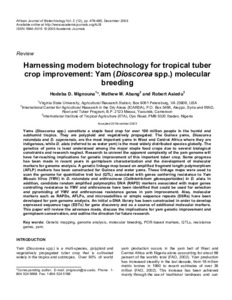| dc.contributor.author | Mignouna, H.D. |
| dc.contributor.author | Abang, Mathew M. |
| dc.contributor.author | Asiedu, Robert |
| dc.date.accessioned | 2019-12-04T11:23:50Z |
| dc.date.available | 2019-12-04T11:23:50Z |
| dc.date.issued | 2003-12 |
| dc.identifier.citation | Mignouna, H.D., Abang, M.M. & Asiedu, R. (2003). Harnessing modern biotechnology for tropical tuber crop improvement: yam (Dioscorea spp.) molecular breeding. African Journal of Biotechnology, 2(12), 478-485. |
| dc.identifier.issn | 1684-5315 |
| dc.identifier.uri | https://hdl.handle.net/20.500.12478/4178 |
| dc.description.abstract | Yams (Dioscorea spp.) constitute a staple food crop for over 100 million people in the humid and subhumid tropics. They are polyploid and vegetatively propagated. The Guinea yams, Dioscorea rotundata and D. cayenensis, are the most important yams in West and Central Africa where they are indigenous, while D. alata (referred to as water yam) is the most widely distributed species globally. The genetics of yams is least understood among the major staple food crops due to several biological constraints and research neglect. Research to unravel the apparent complexity of the yam genome will have far-reaching implications for genetic improvement of this important tuber crop. Some progress has been made in recent years in germplasm characterization and the development of molecular markers for genome analysis. A genetic linkage map based on amplified fragment length polymorphism (AFLP) markers has been constructed for Guinea and water yams. These linkage maps were used to scan the genome for quantitative trait loci (QTL) associated with genes conferring resistance to Yam Mosaic Virus (YMV) in D. rotundata and anthracnose (Colletotrichum gloeosporioides) in D. alata. In addition, candidate random amplified polymorphic DNA (RAPD) markers associated with major genes controlling resistance to YMV and anthracnose have been identified that could be used for selection and pyramiding of YMV and anthracnose resistance genes in yam improvement. Also, molecular markers such as RAPDs, AFLPs, and microsatellites or simple sequence repeats (SSRs) have been developed for yam genome analysis. An initial c-DNA library has been constructed in order to develop expressed sequence tags (ESTs) for gene discovery and as a source of additional molecular markers. This paper will review the advances made, discuss the implications for yam genetic improvement and germplasm conservation, and outline the direction for future research. |
| dc.description.sponsorship | Gatsby Charitable Foundation |
| dc.language.iso | en |
| dc.subject | Yams |
| dc.subject | Dioscorea Rotundata |
| dc.subject | Crop Improvement |
| dc.subject | Modern Biotechnology |
| dc.subject | Molecular Breeding |
| dc.title | Harnessing modern biotechnology for tropical tuber crop improvement: yam (Dioscorea spp.) molecular breeding |
| dc.type | Journal Article |
| dc.type | Journal Article |
| dc.description.version | Peer Review |
| cg.contributor.crp | Roots, Tubers and Bananas |
| cg.contributor.affiliation | Virginia State University |
| cg.contributor.affiliation | International Center for Agricultural Research in the Dry Areas |
| cg.contributor.affiliation | International Institute of Tropical Agriculture |
| cg.coverage.region | Africa |
| cg.coverage.region | West Africa |
| cg.coverage.region | Central Africa |
| cg.coverage.country | Benin |
| cg.coverage.country | Burkina Faso |
| cg.coverage.country | Cote D'Ivoire |
| cg.coverage.country | Ghana |
| cg.coverage.country | Nigeria |
| cg.coverage.country | Sierra Leone |
| cg.coverage.country | Togo |
| cg.authorship.types | CGIAR and advanced research institute |
| cg.iitasubject | Yam |
| cg.iitasubject | Plant Breeding |
| cg.accessibilitystatus | Open Access |
| local.dspaceid | 99744 |
| cg.identifier.doi | https://doi.org/10.5897/AJB2003.000-1097 |

